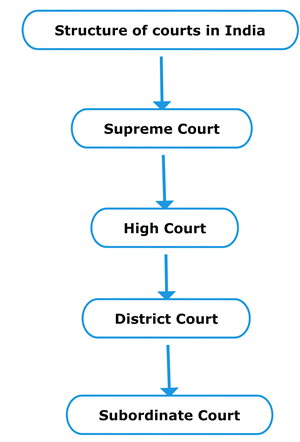PDF chapter test TRY NOW
Hierarchy of Courts in India:
The Indian Judiciary follows an Integrated Judicial structure where all courts of the land are interlinked with each other. It also follows a hierarchy by which their status and functions are discussed below.

Structure of Indian Courts
Supreme Court
2. Can prohibit excess of lower courts and order them to withdraw their jurisdiction by issuing writs.
3. Authorised to issue writs that apply to fundamental rights violations.
4. Empowered to transfer judges from one court to other courts.
5. Decrees or verdicts issued are Binding on all courts of the country.
High Court
2. The highest court of appeal within a state.
3. These courts are not authorised to issue a death sentence for a convict.
4. Powers to issue writs in the case of fundamental rights violation within a state.
5. Appeals from District courts are placed here.
District Courts
2. District Court: Deals with cases regarding civil law in Districts.
3. Sessions Court: Deals with cases regarding criminal law in Districts.
4. The higher appeal from the District court lies in High Court.
Subordinate Courts
Other Courts in India
Revenue Courts
These are courts having jurisdiction under the local law regarding revenue, rents and profits from agricultural land. It doesn’t have original jurisdiction over the subjects.
Fast Track Courts
These are courts created by the government in the year 2000 to reduce the caseloads of higher courts. Clearing the long-pending cases in the district and subordinate courts are its main objective.
Fast track courts: The establishment of the Fast track courts (FTC) are recommended by the Eleventh Finance Commission.
Tele-law Initiative:
It uses technological tools like Video-Conferencing to connect the litigants from remotest parts with the lawyers. This enables speedy justice delivery without wasting money.
Family Courts:
The ultimate objective of the courts is to resolve the disputes emanating from the families. They are designed to tackle family-related issues like Divorce, Custody of the Child, and Adoption. These are civil courts.
Lok Adalats
NALSA: The NALSA is established under the National Legal Service Authority Act of \(1987\).
Disputes in this Lok Adalats have settled amicably with the mutual consent of the parties. The Decrees issued by the Lok Adalats are final and binding on both parties.
The Lok Adalats are headed by sitting or retired judges, and it also includes two other lawyers as its members.
Mobile Courts:
Mobile Courts are created to deliver justice for the poor and needy at the doorstep. These courts generally function on a moving vehicle for easy access to the location.
Haryana: First mobile court in India was inaugurated in the year \(2007\), in the Mewat district of Haryana. The idea of Mobile Court was put forward by the late President A.P.J. Abdul Kalam.
E-Courts

E-Court
The E-Courts project was a mission mode project inaugurated in 2005 by the Ministry of Law and Justice. It works under the tenets of transparency and accessibility, enabling common citizens and advocates to make a direct inquiry regarding the cases.
